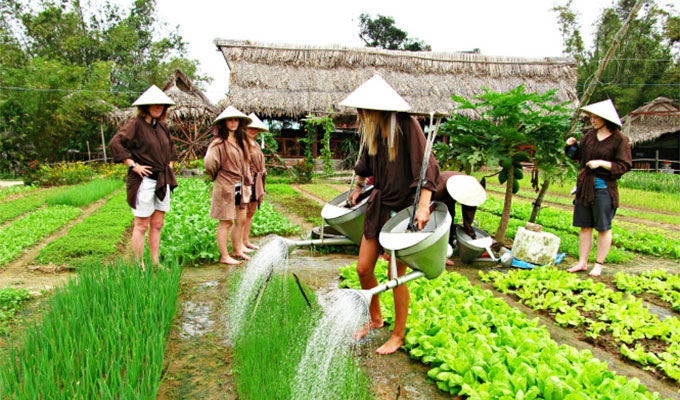In Viet Nam, a country which possesses a time-honoured rice civilisation, with 70% of its population living in rural areas, the partnerships between the tourism and agriculture sectors will undoubtedly generate a positive mutual benefit.

A foreign tourists try watering vegetables in Tra Que village, Hoi An city, Quang Nam province
Agricultural activities will create the foundation for tourism growth. Vice versa, the development of the hospitality sector will contribute to improving the fortunes of rural areas, preserving cultural identity, and increasing the value of farm products.
Visitors to the Central Highlands city of Da Lat are now invited to experience a wide range of agritourism products, including free tours to pick strawberries at Phan Tuan Linh’s garden, exploring the giant pumpkins at Le Huu Phan’s farm, or admiring the brightly-coloured flowers at Da Lat Hasfarm.
Agritourism has become an inevitable trend around the world, and it is seen as a potential gold mine for the development of the tourism sector in Viet Nam, a country with an age-old rice civilisation.
According to a report from the Ho Chi Minh City Tourism Department, the city’s demand for visiting and experiencing farms and fruit gardens has seen an annual increase of 20%-30%, with special attention being paid to high-quality agritourism products.
Ho Chi Minh City Hi-tech Agricultural Park in Cu Chi district welcomed 15,000 visitors in 2017, an increase of more than 200% compared to 2017 when the park was first put into operation.
Over recent years, agritourism products have been developed throughout the country, and have shown positive initial results in visitor popularity.
In the northern region, a wide range of agritourism tours have been designed, allowing visitors to explore the agricultural activities in Ninh Binh and Hai Duong provinces, and study traditional crafts in Bat Trang pottery village, Van Phuc silk village, Dong Ho folk painting making village.
Schoolchildren in Ha Noi can avail of farm tours to Era House farm in Long Bien district, Ba Vi farm in Ba Vi district, and Viet Village farm in Thuong Tin district.
Heading to the northern mountainous region, travellers are invited to to Moc Chau farm in Son La province, where they can admire the stunning rice paddies, and experience the local culture of ethnic villages in Hoa Binh, Son La, Lao Cai, and Ha Giang province.
Visiting the central region, holidaymakers can embark on tours to Tra Que vegetable village in Hoi An city (Quang Nam province), the flower meadows in Da Lat city (Lam Dong province), and coffee plantations in Central Highlands provinces.
The southern region is known for its fruit-laden orchards, floating markets, and beautiful melodies of Don Ca Tai Tu (traditional musical art form of the southerners).
Agritourism targets four goals: combining tourism and agricultural activities, luring tourists, improving farmers’ incomes, and giving tourists the opportunity to enjoy a natural life and experience farming activities.
According to the Viet Nam National Administration of Tourism, agritourism has facilitated the socio-economic development of many localities, making them more attractive to visitors, while generating income for local farmers and agricultural enterprises.
However, agritourism activities still remain spontaneous among farmer households who have not yet paid devoted time to developing a brand, design, and packaging for their products and services, in an effort to make their products more attractive and distinguish them from other neighbouring localities, which can help increase tourists’ spending.
The farm owners have found ways to incorporate local cultural and agricultural practises into their products, which have developed based on the natural ecological environment.
In addition, farmers have shown their lack of skills in serving tourists, organising promotional activities, and coordinating with travel agents to promote their agritourist sites to visitors.
To tackle the shortcomings, the Viet Nam National Administration of Tourism has launched the One Commune One Product (OCOP) programme, requiring each locality to develop their own unique tourist product while providing them with preferential policies on improving their access to capital, encouraging agricultural activities, and enhancing infrastructure in rural areas.
It is also important to strengthen the bond between relevant parties in boosting the agritourism model, including farmers, travel agents, local authorities, and the management agencies of tourist, agricultural, and trading activities.
Investment in high-tech agriculture by major groups such as Vingroup, TH, and FLC is expected to expand agritourism through the development of agricultural products and the commercialisation of farms and agritourism products to better serve visitors.
In addition, their projects for developing community-based tourism and ecological tourism in accordance with agricultural production space are also predicted to create greater added value for agritourism activities.